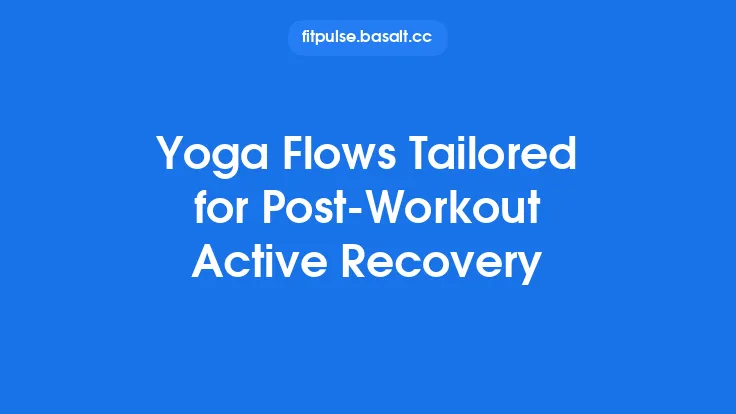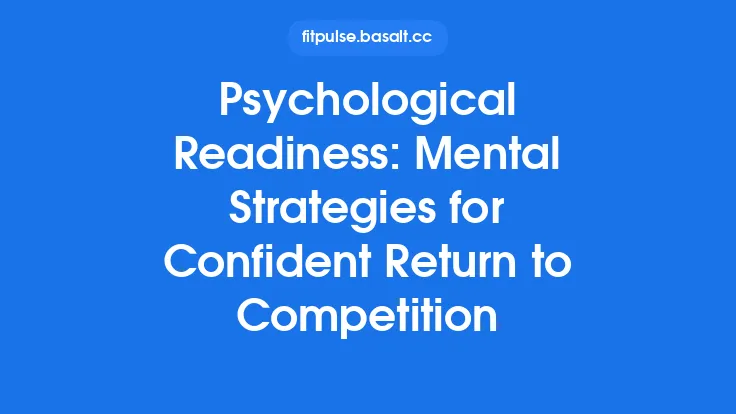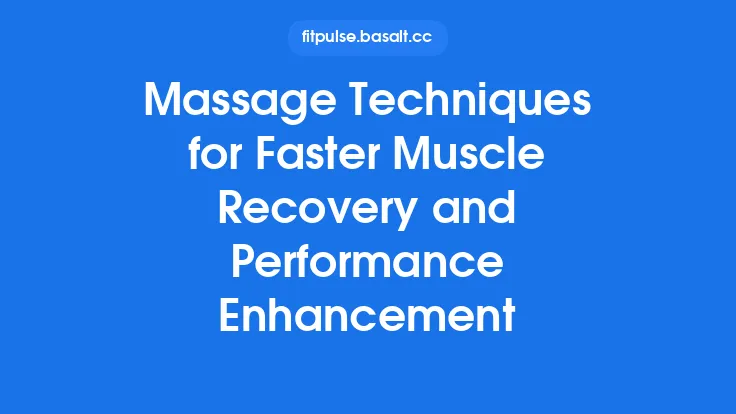Recovering from intense training, injury, or everyday life stress is a multifaceted challenge. While traditional recovery protocols often focus on nutrition, rest, and targeted therapies, an emerging body of evidence suggests that a truly holistic approach—one that addresses the body, mind, and environment together—can more effectively lower cortisol, the primary stress hormone, and accelerate the healing process. Below is a comprehensive guide to the most reliable, evergreen strategies for reducing cortisol levels and promoting faster, more resilient recovery.
Understanding Cortisol and Its Role in Recovery
Cortisol is produced by the adrenal cortex in response to signals from the hypothalamic‑pituitary‑adrenal (HPA) axis. In short bursts, it is essential: it mobilizes glucose, supports cardiovascular function, and modulates inflammation. However, chronic elevation—common after prolonged training cycles, injury, or psychological stress—can:
- Impair protein synthesis, slowing muscle repair.
- Increase catabolism, leading to muscle loss.
- Suppress immune function, making infections more likely.
- Disrupt sleep architecture, further hampering recovery.
Balancing cortisol does not mean eliminating it; rather, the goal is to maintain a healthy diurnal rhythm—high in the morning to aid wakefulness, tapering toward low levels at night to permit restorative sleep.
Nutrition Strategies to Modulate Cortisol
1. Balanced Macronutrient Timing
- Carbohydrate intake post‑exercise stimulates insulin, which antagonizes cortisol release. Aim for a 3:1 carbohydrate‑to‑protein ratio within 30–60 minutes after training.
- Protein quality matters; leucine‑rich sources (whey, soy, eggs) support mTOR signaling, counteracting cortisol‑driven muscle breakdown.
2. Micronutrient Support
- Magnesium (300–400 mg/day) stabilizes neuronal excitability and has been shown to blunt cortisol spikes during stress tests.
- Vitamin C (500–1000 mg/day) reduces cortisol output in acute stressors by supporting adrenal antioxidant capacity.
- B‑vitamins (especially B5 and B6) are co‑factors in cortisol synthesis; ensuring adequate intake prevents overproduction due to enzymatic bottlenecks.
3. Anti‑Inflammatory Foods
- Omega‑3 fatty acids (EPA/DHA 1–2 g/day) modulate the NF‑κB pathway, lowering systemic inflammation and indirectly reducing cortisol.
- Polyphenol‑rich foods (berries, green tea, dark chocolate) inhibit cortisol‑inducing enzymes and improve endothelial function.
4. Glycemic Control
- Avoid excessive refined sugars that cause rapid insulin spikes followed by reactive hypoglycemia, a known trigger for cortisol release.
- Incorporate low‑glycemic index carbs (legumes, whole grains) to maintain stable blood glucose and a calmer HPA axis.
5. Hydration and Electrolytes
Dehydration raises cortisol by activating the sympathetic nervous system. Aim for 2.5–3 L of water daily, supplemented with electrolytes (sodium, potassium, magnesium) after heavy sweating.
Optimizing Sleep and Circadian Rhythms
1. Consistent Sleep‑Wake Schedule
Going to bed and waking at the same time each day reinforces the natural cortisol rhythm. Even on rest days, maintain a ±30‑minute window.
2. Light Exposure Management
- Morning bright light (≥10,000 lux for 20–30 min) suppresses melatonin and signals the HPA axis to produce cortisol appropriately.
- Evening dim lighting (≤30 lux) encourages melatonin secretion, facilitating the natural cortisol decline.
3. Temperature Regulation
A cool bedroom environment (16–19 °C) promotes deeper slow‑wave sleep, during which cortisol reaches its nadir.
4. Pre‑Sleep Rituals
Limit stimulants (caffeine, nicotine) after 2 p.m., and avoid heavy meals within 2 hours of bedtime. A short warm bath can trigger a post‑bath drop in core temperature, signaling the body to prepare for sleep.
Herbal and Nutraceutical Adaptogens
Adaptogens are natural compounds that help the body adapt to stress without directly sedating or stimulating. Research supports several for cortisol modulation:
| Adaptogen | Typical Dose | Mechanism |
|---|---|---|
| Ashwagandha (Withania somnifera) | 300–600 mg standardized extract (withanolides) | Reduces HPA axis activation; lowers cortisol by ~30% in controlled trials. |
| Rhodiola rosea | 200–400 mg (standardized to rosavins & salidroside) | Enhances cellular resilience, attenuates cortisol spikes during physical stress. |
| Holy Basil (Ocimum sanctum) | 300–500 mg extract | Modulates glucocorticoid receptors, supporting balanced cortisol feedback. |
| Panax ginseng | 200–400 mg (ginsenosides) | Improves energy metabolism while dampening cortisol response to acute stress. |
When integrating adaptogens, start with half the recommended dose for 1–2 weeks to assess tolerance, then gradually increase to the target dose.
Physical Modalities: Massage, Acupuncture, and Movement Therapies
1. Therapeutic Massage
Manual manipulation reduces sympathetic activity and stimulates parasympathetic pathways, leading to a 10–20% reduction in cortisol measured 30 minutes post‑session. Focus on myofascial release and lymphatic drainage to enhance metabolic waste clearance.
2. Acupuncture
Specific points (e.g., LI4, SP6, and GV20) have been shown to modulate the HPA axis, decreasing cortisol by up to 15% after a series of weekly treatments. Choose licensed practitioners experienced in sports recovery.
3. Mind‑Body Movement Practices (Tai Chi, Qigong)
These low‑impact, flow‑based disciplines synchronize breath, posture, and gentle movement, fostering a balanced autonomic state. Regular practice (3–4 sessions/week, 30 min each) has been linked to lower basal cortisol and improved heart‑rate variability (HRV).
4. Low‑Intensity Aerobic “Active Recovery”
Light cycling, swimming, or walking at 40–50% VO₂max promotes circulation without triggering a cortisol surge, facilitating nutrient delivery and metabolic waste removal.
Thermal Therapies: Cold Exposure and Heat Stress
1. Cold Water Immersion (CWI)
Immersing the body in 10–15 °C water for 5–10 minutes post‑exercise reduces inflammation and can blunt the cortisol response to subsequent stressors. Frequency: 2–3 times per week, avoiding daily use to prevent over‑suppression of the immune system.
2. Contrast Therapy (Alternating Hot/Cold)
Switching between hot (38–40 °C) and cold (10–12 °C) phases for 1–2 minutes each, repeated 3–4 cycles, stimulates vascular “pump” action, improves lymphatic flow, and balances autonomic tone.
3. Sauna (Infrared or Traditional)
Heat exposure at 80–90 °C for 15–20 minutes elevates heart rate and induces a hormetic stress response that, paradoxically, lowers resting cortisol over time by enhancing heat‑shock protein expression and improving sleep quality.
Environmental and Lifestyle Factors
1. Reducing Endocrine Disruptors
Chemicals such as BPA, phthalates, and certain pesticides can interfere with cortisol metabolism. Opt for glass or stainless‑steel containers, choose organic produce, and limit exposure to plastics, especially when heating food.
2. Digital Detox and Blue‑Light Management
Excessive screen time, especially in the evening, disrupts melatonin and can keep cortisol elevated. Use blue‑light filters after sunset and schedule screen‑free periods (minimum 1 hour before bed).
3. Nature Exposure (“Green Therapy”)
Spending 30–60 minutes in natural settings (parks, forests, near water) reduces cortisol by up to 20% in acute studies, likely via a combination of visual, auditory, and olfactory stimuli that promote parasympathetic activation.
4. Structured Routine and Predictability
A predictable daily schedule reduces perceived uncertainty, a major driver of cortisol release. Incorporate consistent meal times, training windows, and recovery blocks to signal safety to the nervous system.
Social Connection and Emotional Well‑Being
Human interaction is a potent modulator of the HPA axis. Positive social experiences trigger oxytocin release, which inhibits cortisol secretion. Strategies include:
- Regular group activities (team sports, club meetings) that foster camaraderie.
- Scheduled “check‑in” conversations with coaches, teammates, or mentors to discuss progress and concerns.
- Pet ownership or animal‑assisted activities, which have been shown to lower cortisol during brief interactions.
Even brief, meaningful conversations can produce measurable cortisol reductions, underscoring the importance of integrating social support into any recovery plan.
Integrating a Holistic Plan: Practical Steps for Athletes and Active Individuals
- Baseline Assessment
- Measure resting cortisol (salivary or serum) at waking and bedtime for 3 consecutive days.
- Record sleep quality (actigraphy or sleep diary), nutrition logs, and perceived stress scores (e.g., PSS‑10).
- Create a Weekly Blueprint
- Monday–Wednesday: High‑intensity training + post‑session low‑intensity active recovery + protein‑carb snack.
- Thursday: Light movement practice (Tai Chi) + massage or self‑myofascial release.
- Friday: Strength session + adaptogen (ashwagandha) + CWI.
- Saturday: Outdoor activity (hiking) + social gathering.
- Sunday: Full rest, sleep hygiene focus, sauna session, and digital detox.
- Nutrient Timing
- Pre‑training: Small carbohydrate‑protein blend 30 min prior.
- Post‑training: 0.3 g/kg protein + 0.9 g/kg carbohydrate within 30 min.
- Evening: Magnesium‑rich snack (e.g., pumpkin seeds) and a low‑glycemic dinner.
- Monitoring and Adjustment
- Re‑measure cortisol after 4 weeks; aim for a 10–15% reduction in evening levels.
- Adjust sleep window, adaptogen dose, or thermal therapy frequency based on trends.
- Use HRV tracking as an additional proxy for autonomic balance.
Monitoring Progress and Adjusting the Approach
- Objective Biomarkers: Salivary cortisol, HRV, resting heart rate, and inflammatory markers (CRP, IL‑6).
- Subjective Metrics: Mood questionnaires, perceived recovery scales, and sleep quality ratings.
- Technology Aids: Wearable devices that capture HRV and sleep stages can provide daily feedback, allowing fine‑tuning of recovery interventions.
When progress stalls, consider the following troubleshooting steps:
| Symptom | Likely Culprit | Adjustment |
|---|---|---|
| Persistent morning cortisol elevation | Inadequate light exposure or excessive caffeine | Increase morning bright‑light exposure; limit caffeine after 12 p.m. |
| Nighttime cortisol spikes | Late‑night screen use or irregular bedtime | Implement blue‑light blocking glasses; enforce a consistent bedtime routine. |
| Low HRV despite good sleep | Over‑training or insufficient omega‑3 intake | Reduce training volume; increase EPA/DHA supplementation. |
| Elevated perceived stress | Social isolation or chronic noise exposure | Schedule regular social activities; create a quiet, calming sleep environment. |
Bottom line: Reducing cortisol for faster recovery is not a single‑pill solution. It requires a coordinated, holistic strategy that blends nutrition, sleep hygiene, targeted physical therapies, environmental stewardship, and meaningful social connections. By systematically applying these evergreen principles, athletes and active individuals can restore a healthy cortisol rhythm, protect tissue integrity, and accelerate the journey from stress to optimal performance.





